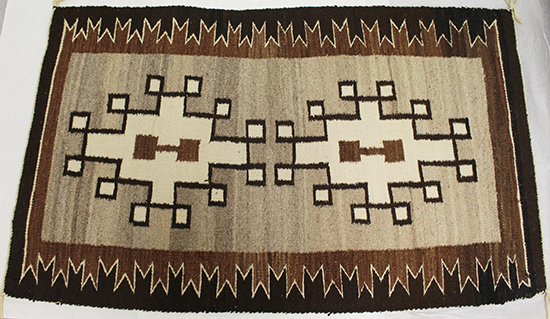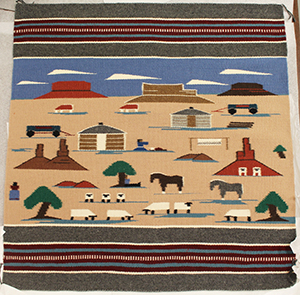Navajo: Let’s Weave
Who are the Navajo?
The Navajo, who call themselves Diné, are the second largest American Indian group in the United States. There are around 300,500 enrolled tribal members.

The Diné have the largest reservation in the country. The reservation straddles what is called the Four Corners region and covers more than 27,000 square miles of land in Arizona, Utah and New Mexico.
The Navajo language is spoken throughout the region, although most Navajo also speak English.
Weaving
The Diné are famous for weaving. They have been weaving for hundreds of years and the weaving techniques have changed very little over time. However, the materials used and the types of items the Navajo weave have changed.
There is much debate about when and how the Diné learned to weave. However, the Diné have their own story about how they learned to weave. They believe that the Spider Woman bought them the gift of weaving. Click here to hear the story of Spider Woman.
Originally, the Diné used cotton and wove on upright looms. When the Spanish arrived in the 1500s, the Diné traded with them for Churra sheep. From those Spanish sheep, the Diné developed a breed of sheep called the Navajo-Churro which is still raised today. Since the introduction of sheep, wool replaced cotton as the material used for weaving.
Today the Diné are famous as weavers of wool rugs, but traditionally they wove blankets and clothing like shirts, wrap-around dresses, hair ties, and belts. The Diné began to weave rugs for economic reasons. In the late 1800s, as more people moved west and tourists came into contact with the Diné, they were interested in Navajo weavings, but they didn’t want clothing, they wanted wall hangings and rugs. So, the Diné changed from weaving blankets and clothes to weaving rugs they could sell.

This rug from the Lam Museum collection shows the Two Grey Hills pattern.
Diné women do most of the work to create a rug. Making a rug is a long process that can take several months to years depending on its size. The process starts by cutting the wool. The wool is then washed, combed, spun into yarn, and dyed. Dyes are created from natural materials like clay, minerals, leaves, flowers, berries, and bark. Today some commercial dyes are used, but most Diné still prefer to use natural dyes and colors.
Once a weaver has all the yarns, they begin a rug. They still weave on an upright loom, and a weaver starts from the bottom and weaves to the top of the loom.

This contemporary rug from the Lam Museum collection depicts a farm scene.
The design for a rug is kept in the mind of the weaver. They don’t make drawings or pictures, but weave the pattern asthey go along. The patterns and designs have names. Most designs reflect the natural world the Diné see around them. Some rugs tell stories of the Diné people. More contemporary rugs have abstract, still life, or pictorial designs.
The Diné consider weaving a spiritual experience and an important part of their lives. They believe that as a woman weaves part of her spirit becomes part of the rug. However, a weaver will leave small imperfection in her rug so her spirit isn’t trapped in the rug.

This rug from the Lam Museum collection shows Yei, Navajo spirit beings.
To hear more about weaving here are links to hear from two Diné weavers:
The Navajo Oral History Project: Nita Nez speaking in the Navajo language about weaving
Virginia Museum of Fine Art interview with weaver D.Y. Begay
Let’s Weave!
We have two project options: weaving with paper or weaving with yarn.
For paper weaving, you will need:
• Colored construction paper
• Ruler
• Pencil
• Scissors
For yarn weaving, you will need:
• Piece of cardboard (to make loom)
• Ruler
• Pencil or marker
• Scissors
• Yarn
